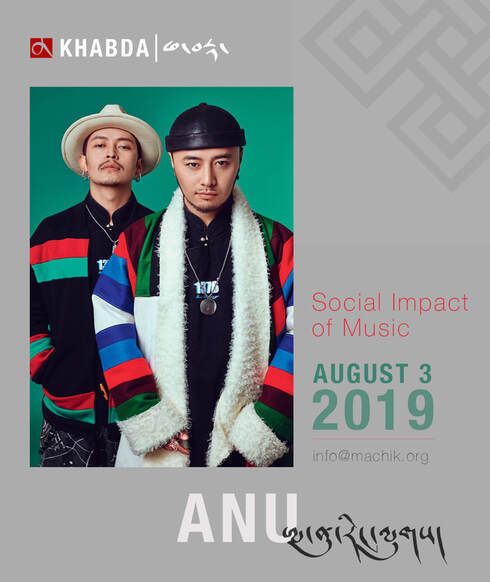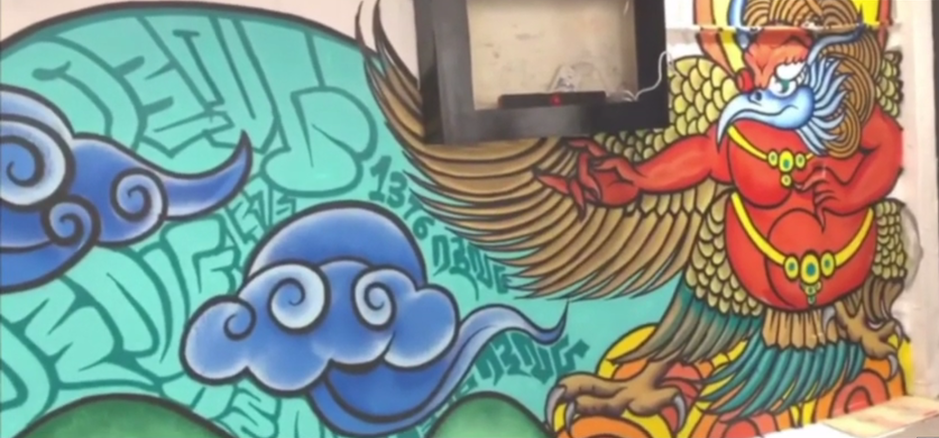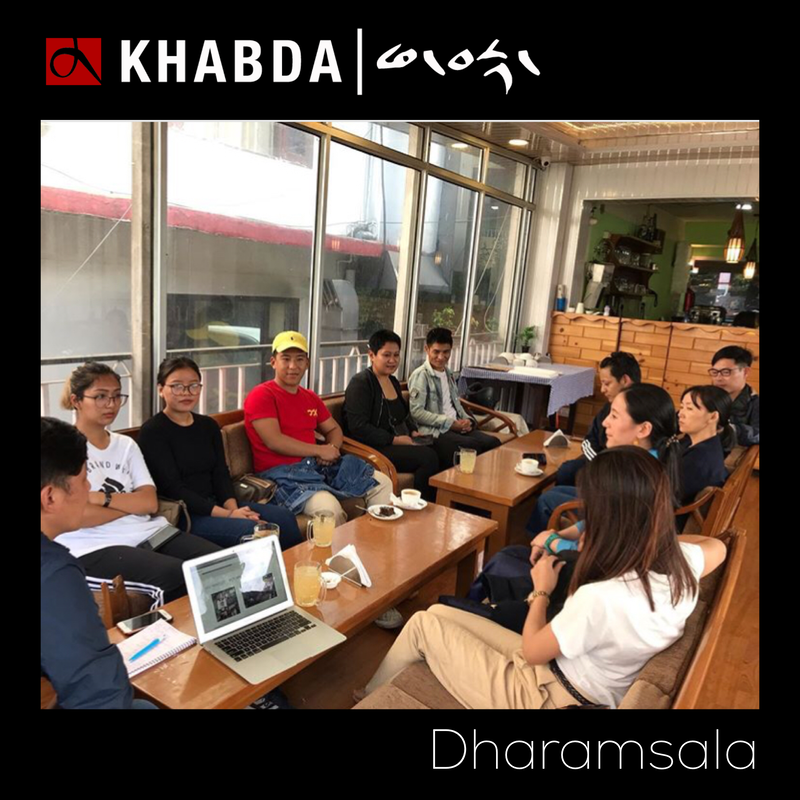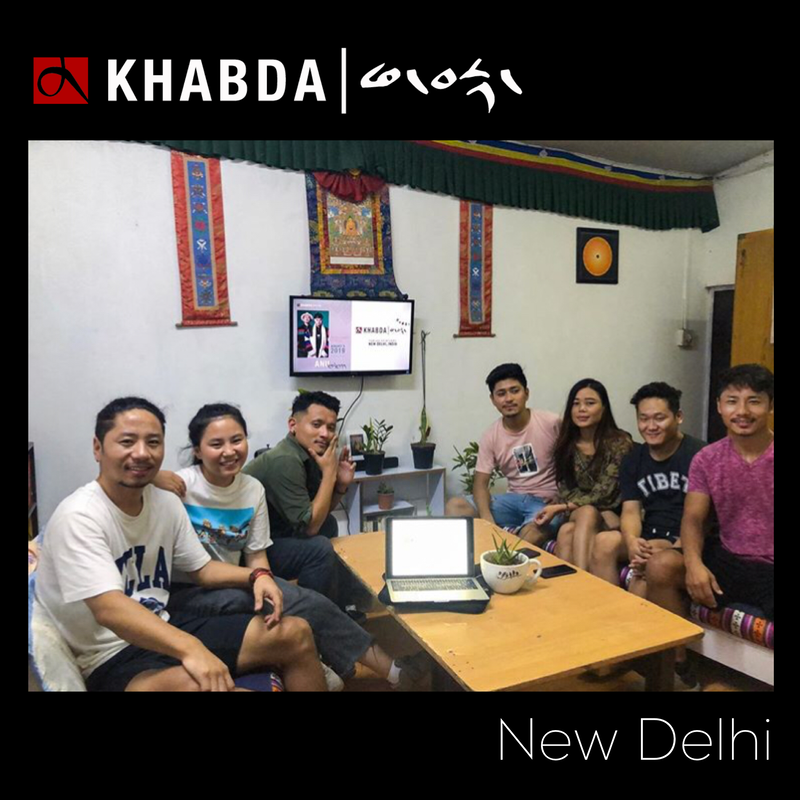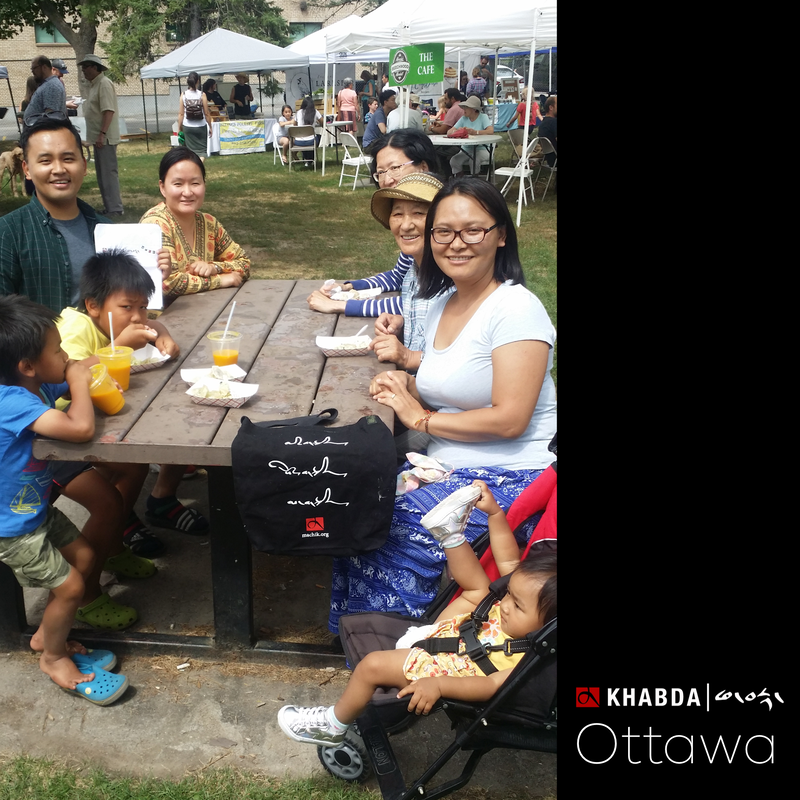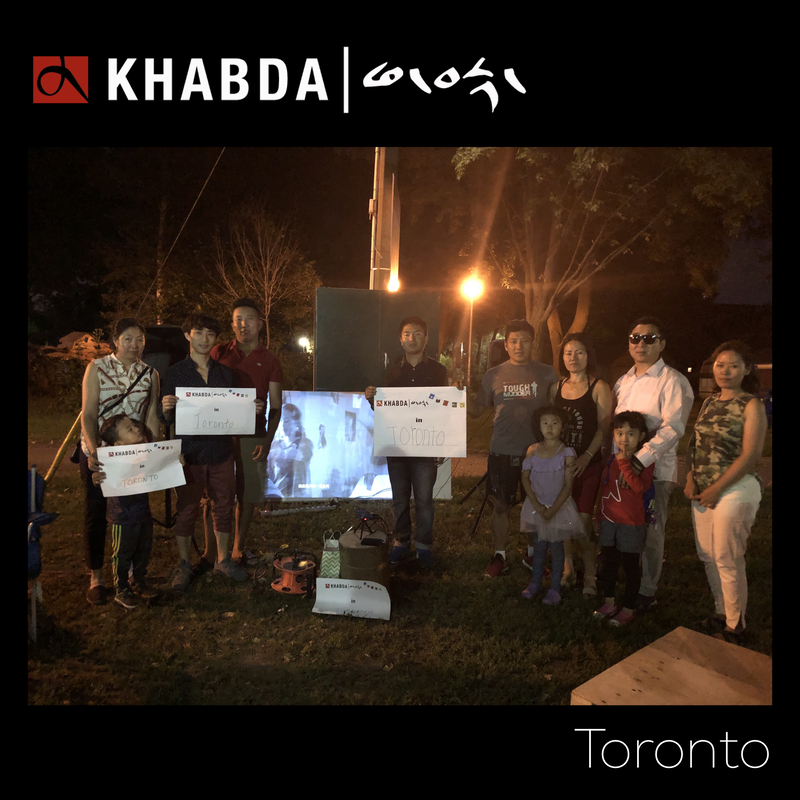|
The fourth Machik Khabda took place in 20 locations around the world on Saturday, August 3, 2019. We hope that everyone involved in these local conversations had a stimulating and meaningful experience as we explored the social power of music through the phenomenon that is Anu Ranglug, a.k.a. ANU. In a context of rapid change in Tibet and beyond, we contemplated and considered one of the main questions arising from ANU’s creative work: What does it mean to fly?
To get involved with Machik Khabda, you can host a Khabda or join a local group, by contacting [email protected]. You can also join the Khabda mailing list, or follow us on Instagram, Facebook or Twitter.
|
ANU RANGLUG | ཨ་ནུ་རིང་ལུགས།
|
|
|
Anu Ranglug: A Tibetan Phenomenon
Exploding onto the Tibetan music scene with their hit single འཕུར། (En: Fly, pronounced: phur), the talented duo of ANU, known before as Anu Ranglug, has emerged as one of the leading pop stars from Tibet. Performing across Tibet and the PRC, their popularity continues to soar. Recently they were featured on Singer, the most popular Chinese televised singing competition, where they performed largely in Tibetan language and featured a traditional Tibetan performer in their rendition of "Apologize." ANU is not only a great success across Tibet but also in the span of the global Tibetan diaspora.
Exploding onto the Tibetan music scene with their hit single འཕུར། (En: Fly, pronounced: phur), the talented duo of ANU, known before as Anu Ranglug, has emerged as one of the leading pop stars from Tibet. Performing across Tibet and the PRC, their popularity continues to soar. Recently they were featured on Singer, the most popular Chinese televised singing competition, where they performed largely in Tibetan language and featured a traditional Tibetan performer in their rendition of "Apologize." ANU is not only a great success across Tibet but also in the span of the global Tibetan diaspora.
Crossing Boundaries Through Music
Music connects people across generations, cultures, and even languages. ANU’s music has found popularity well beyond Tibet and is a reflection of their commitment to their creative vision. As two young Tibetans competing within a wider music industry in which both Tibetans and hip hop are not in the mainstream, their choice of singing mostly in Tibetan language is a rare accomplishment. While they occasionally sing in Chinese, they also feature many elements of traditional Tibetan music and culture.
More recently, ANU’s significant popularity, as with a number of other Tibetan performers, has become even more compelling because a growing portion of their audience does not share the performers’ cultural references. ANU’s capacity to cross over to a wider PRC audience is certainly not new. Artists such as Yadong, who precede ANU, have played a key role in opening a space for non-Tibetan speakers to listen and enjoy music in Tibetan language. In recent years, there have been more Tibetan performers singing in Tibetan language and incorporating some traditional Tibetan styles into their music at various singing competitions held in China. Artists Tashi Phuntsok and Tenzin Nyima are such examples. Both participated and won the popular singing competition Sing! China in 2017 and 2018 respectively.
Music connects people across generations, cultures, and even languages. ANU’s music has found popularity well beyond Tibet and is a reflection of their commitment to their creative vision. As two young Tibetans competing within a wider music industry in which both Tibetans and hip hop are not in the mainstream, their choice of singing mostly in Tibetan language is a rare accomplishment. While they occasionally sing in Chinese, they also feature many elements of traditional Tibetan music and culture.
More recently, ANU’s significant popularity, as with a number of other Tibetan performers, has become even more compelling because a growing portion of their audience does not share the performers’ cultural references. ANU’s capacity to cross over to a wider PRC audience is certainly not new. Artists such as Yadong, who precede ANU, have played a key role in opening a space for non-Tibetan speakers to listen and enjoy music in Tibetan language. In recent years, there have been more Tibetan performers singing in Tibetan language and incorporating some traditional Tibetan styles into their music at various singing competitions held in China. Artists Tashi Phuntsok and Tenzin Nyima are such examples. Both participated and won the popular singing competition Sing! China in 2017 and 2018 respectively.
Selected Learning Materials
Below, you will find the following complementary learning materials for this Khabda: an ANU timeline, ANU infographic, lyrics in Tibetan and English to four ANU songs, and a discussion guide curated by the Machik team. We hope these materials are useful in your local conversations for creating open, creative and exploratory Khabdas. We would like to thank High Peaks Pure Earth and Bhuchung D Sonam for their work on translating ANU Ranglug's songs from Tibetan to English.
|
| ||||||||||||||||||||||||||||||||||||
| Fly_lyrics.pdf | |
| File Size: | 1531 kb |
| File Type: | |
Hip Hop's Social Tradition
Both Tibetan and Chinese hip hop artists borrow greatly from American hip hop culture, as do many artists around the world. For a more context on hip hop, historian and writer Jeff Chang’s work provide an in-depth historical exploration of this music genre.
Since its origin with Jamaican-born music innovator DJ Kool Herc in the Bronx, hip hop's roots run deep. A tradition of creativity, self-reliance, high energy, and socio-political awareness has morphed quickly into a music phenomenon and movement that has become truly global.
ANU’s approach of youthful energy and “flying” resonates well with the ethos of hip hop and its four key elements of music/singing, production/DJ-ing, graffiti/street art and dancing. For the 4th Machik Khabda, we are excited to invite you to consider ANU’s music (with lyrics in Tibetan and English), their creative ecosystem (which includes other Tibetan rap artists such as TSP and Young13DBaby who recently performed at SXSW this year), and their vision and inspiration. We truly look forward to hearing your thoughts from around the world!
For more on hip hop’s history, the complexities of its transformation into a global phenomenon, and the current hip hop scene in Tibet, please consider the following:
Since its origin with Jamaican-born music innovator DJ Kool Herc in the Bronx, hip hop's roots run deep. A tradition of creativity, self-reliance, high energy, and socio-political awareness has morphed quickly into a music phenomenon and movement that has become truly global.
ANU’s approach of youthful energy and “flying” resonates well with the ethos of hip hop and its four key elements of music/singing, production/DJ-ing, graffiti/street art and dancing. For the 4th Machik Khabda, we are excited to invite you to consider ANU’s music (with lyrics in Tibetan and English), their creative ecosystem (which includes other Tibetan rap artists such as TSP and Young13DBaby who recently performed at SXSW this year), and their vision and inspiration. We truly look forward to hearing your thoughts from around the world!
For more on hip hop’s history, the complexities of its transformation into a global phenomenon, and the current hip hop scene in Tibet, please consider the following:
- Fight the Power: The most provocative song ever on BBC Culture, (2019-06-28)
- Chengdu Cool: The Rise of Sichuan’s Homegrown Hip Hop on Guernica, (2018-08-29)
- Chengdu Emerges As A New Home For Chinese Hip-Hop on NPR, (2018-02-01)
- Fighting the power and speaking for the earth: The explosion of Native American hip-hop on Salon, (2016-06-08)
- Live studio performance of “Prayer Loop Song” by Apsáalooke (Crow) rapper Supaman, (2014-02-20)
- Interview with Sa-Roc, second female rapper signed to Minneapolis-based label Rhymesayers. (2016-06-10)
- Crunk Feminist Collective “Where Crunk Meets Conscious and Feminism Meets Cool”: Excellent blog for feminist writing on hip hop (U.S. focused). Find the recent essay collection here.
ABOUT THE ARTISTS
|
Payag (left): Born in Nangchen, Kham, Payag studied music at Qinghai Normal University in Xining before moving to work in Beijing. Later while living in Beijing, he continued to return home to Nangchen to spend time with local musicians who he cites as a major influence on his music today.
Gonpa (right): Born in Nangchen, Kham, Gonpa’s musical inclinations began early in elementary school where he played flute and sang traditional Tibetan folk songs. He later studied Tibetan language and culture at Southwest University for Nationalities in Chengdu, Sichuan. A poem he wrote early on then became the basis of ANU's hit song "Phur." |
Gonpa and Payag formed the sensational Tibetan contemporary music group ANU (also known as Anu Ranglug) in 2012 and chose this name referring to a youthful way of being. The members of ANU are from Nangchen, near Jyekundo in Kham, and at college they studied music, art and Tibetan culture, after which the two headed to Beijing. As early as in 2014, ANU won acclaim at singing competitions inside Tibet and China. The artists refused offers from music agencies in order to maintain their creative freedom and soon formed their own entertainment company in 2016. Their first EP which included two songs: “ANU” (ཨ་ནུ།) and "Leaving Home" (ཡུལ་ནས་ཡོང་དུས།) was released in July 2016 and their first single called “Joke” (རྩེད་མོ།) was released four months later. In May of 2017, their hit single “Phur” (འཕུར།) became a music phenomenon across Tibet and with this new momentum ANU toured across Tibet with nearly 50 performances. In early 2019, they reached even wider audiences as competitors on Singer, the second-most watched PRC singing competition TV show. At the moment, ANU has a total of eight songs with the most recent being "Sarduba" (གསར་གཏོད་པ།) which was released in June 2019.
In addition to their success in music, the two have also created a popular clothing brand called 1376 featuring an innovative blend of both traditional Tibetan aesthetics and contemporary western street styles sold at their store in Jithang (Xining, Amdo).
In addition to their success in music, the two have also created a popular clothing brand called 1376 featuring an innovative blend of both traditional Tibetan aesthetics and contemporary western street styles sold at their store in Jithang (Xining, Amdo).
Be part of the Khabda community
To learn more about becoming a local Khabda host in your community, contact us at [email protected].
- Find out where local Machik Khabdas are taking place by contacting [email protected]
- Share your thoughts on ANU on Instagram and Facebook using hashtags #AnuRanglug and #machikkhabda
- We want to hear from you! What are your ideas, questions, and thoughts on ANU? Write a blog post, music video review, lyrics analysis and share it with us @machik_online or [email protected]!
- Check back here for news and updates from the Machik Khabda community.
To learn more about becoming a local Khabda host in your community, contact us at [email protected].
Discussing the Social Impact of ANU's Music
Our fourth Khabda, held around the world on 3rd August, welcomed 20 different conversation groups from Chicago to New York to Kathmandu to Ladakh and beyond. As always, we are truly grateful to the time, care and dedication shown by our host and their local communities for convening together to further explore, discuss and learn about diverse cultural forms emerging from inside Tibet today. Thank you!
As the focus of this Khabda ran along the lines of better understanding ANU's social impact through music, we heard back plenty from our local groups on this note. From dissecting the lyrics of Fly and other songs, to admiring their creative use of Tibetan language, to developing a communications bridge for Tibetans in diaspora to stay informed on the everyday-ness of life in Tibet, to offering practical and spiritual advice for life, there is so much more to uncover and digest. We hope people will continue to tread along this pathway for collective exploration and learning, and further harness their curiosity and passion for Tibet. To stay informed on Khabda news, please fill this form.
Our fourth Khabda, held around the world on 3rd August, welcomed 20 different conversation groups from Chicago to New York to Kathmandu to Ladakh and beyond. As always, we are truly grateful to the time, care and dedication shown by our host and their local communities for convening together to further explore, discuss and learn about diverse cultural forms emerging from inside Tibet today. Thank you!
As the focus of this Khabda ran along the lines of better understanding ANU's social impact through music, we heard back plenty from our local groups on this note. From dissecting the lyrics of Fly and other songs, to admiring their creative use of Tibetan language, to developing a communications bridge for Tibetans in diaspora to stay informed on the everyday-ness of life in Tibet, to offering practical and spiritual advice for life, there is so much more to uncover and digest. We hope people will continue to tread along this pathway for collective exploration and learning, and further harness their curiosity and passion for Tibet. To stay informed on Khabda news, please fill this form.
THANK YOU -
A special thank-you to the following people for their help in the curation process of this Khabda: Katie Cunningham, Tenzin Dickyi, Chelsea Hall, Katie Jarrett, Khando Langri, Quinn Lehrman and Losang Nyima. We are also grateful to Bhuchung D Sonam and High Peaks Pure Earth for their English translations of the ANU songs we reference through this Khabda!
A special thank-you to the following people for their help in the curation process of this Khabda: Katie Cunningham, Tenzin Dickyi, Chelsea Hall, Katie Jarrett, Khando Langri, Quinn Lehrman and Losang Nyima. We are also grateful to Bhuchung D Sonam and High Peaks Pure Earth for their English translations of the ANU songs we reference through this Khabda!
